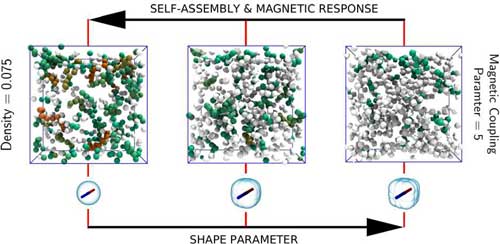| Posted: Aug 10, 2017 | |
The shape of nanoparticles influences the magnetic response of ferro-colloids(Nanowerk News) The rationale behind work from scientists in Austria and Russia, just reported in ACS Nano ("Nanoparticle Shape Influences the Magnetic Response of Ferro-Colloids"), was a simple one: What effect does particle shape, cubic geometry in particular, have on the corresponding magnetic response of a stable magnetic fluid of colloidal superballs? |
|
 |
|
| Simulation snapshots. (© ACS) (click on image to enlarge) | |
| The desire to address this question was motivated by the suspicion that owing to the preference of cubic particles with a [001] dipole to form chain aggregates, higher values of the initial static magnetic susceptibility (ISMS) could have been achievable. | |
| A supposition based on the fact that chains are a much more field-favorable cluster topology than rings. At the 'ambient' temperature conditions considered in this work, the contribution of ring structures to the susceptibility of spheres is somewhat negligible. | |
| This shifts the dependency of the ISMS from the explicit topology of clusters that result from self-assembly to the two-particle bonding process itself. In this way, the researchers managed to attribute the q-induced drop in ISMS to this basic consideration, correcting in the process their initial preconceptions. | |
| "Our understanding of the system was enriched by a detailed analysis of the nanoparticles at each state point," they write. "This analysis not only corroborated the conclusions drawn from the computation of the ISMS but also facilitated the understanding of the self-assembly mechanisms in effect." | |
| The ability to visualize the aggregation in the system allowed for the significantly less correlated cubic systems to be easily identified. | |
| Furthermore, the team's modifications to the existing modified mean-field theory (MMFT) have proved valid. The resulting framework – particularly at low volume fractions and moderate magnetic coupling – faithfully represents the variation in the response of the system as a function of the shape parameter. | |
| "At first glance, it would appear that the tempered response of more cube-like particles is somewhat of a set back toward the aim of producing more field-responsive magnetic liquids," according to the scientists. "Be that as it may, there are a number of scenarios we can foresee where the opportunity for cubic particles to exhibit an advantage over their spherical counterparts may persist." | |
| The indicators of such prospects are found in the results of this work, but the scientists note that further study is required to confirm these conjectures. | |
| The first of these scenarios has been alluded to previously, namely, the effect of temperature. Although the persistence of ring structures for similarly q-valued superballs was recently reported (Nanoscale, "How Cube-Like must Magnetic Nanoparticles be to Modify their Self-Assembly?"), the likelihood of the abrupt decrease in ISMS with decreasing temperature is unlikely. | |
| Thus, the prospect of cubic particles being more suitable for low temperature conditions is still very much in the cards. | |
| According to the team, the second scenario that comes to mind is one where a sharper transition in terms of magnetic coupling strength is required. Careful consultation of the cluster analysis (numerical and pictorial) seems to indicate the possibility that the transition from a dispersed to an aggregated system occurs more quickly (i.e., over a smaller range of λ) as the particles become more cubic. | |
| "The evolution in the aggregation of the spherical system appears more gradual," the authors conclude their report. "Thus, one can envisage the situation where a fluid with a sharper transition would benefit applications where the switchable nature of a ferro-colloid is of primary concern. Two state binary operation may allow for greater precision to be achieved." |
 By
Michael
Berger
– Michael is author of three books by the Royal Society of Chemistry:
Nano-Society: Pushing the Boundaries of Technology,
Nanotechnology: The Future is Tiny, and
Nanoengineering: The Skills and Tools Making Technology Invisible
Copyright ©
Nanowerk LLC
By
Michael
Berger
– Michael is author of three books by the Royal Society of Chemistry:
Nano-Society: Pushing the Boundaries of Technology,
Nanotechnology: The Future is Tiny, and
Nanoengineering: The Skills and Tools Making Technology Invisible
Copyright ©
Nanowerk LLC
|
|
|
Subscribe to a free copy of one of our daily Nanowerk Newsletter Email Digests with a compilation of all of the day's news. |
